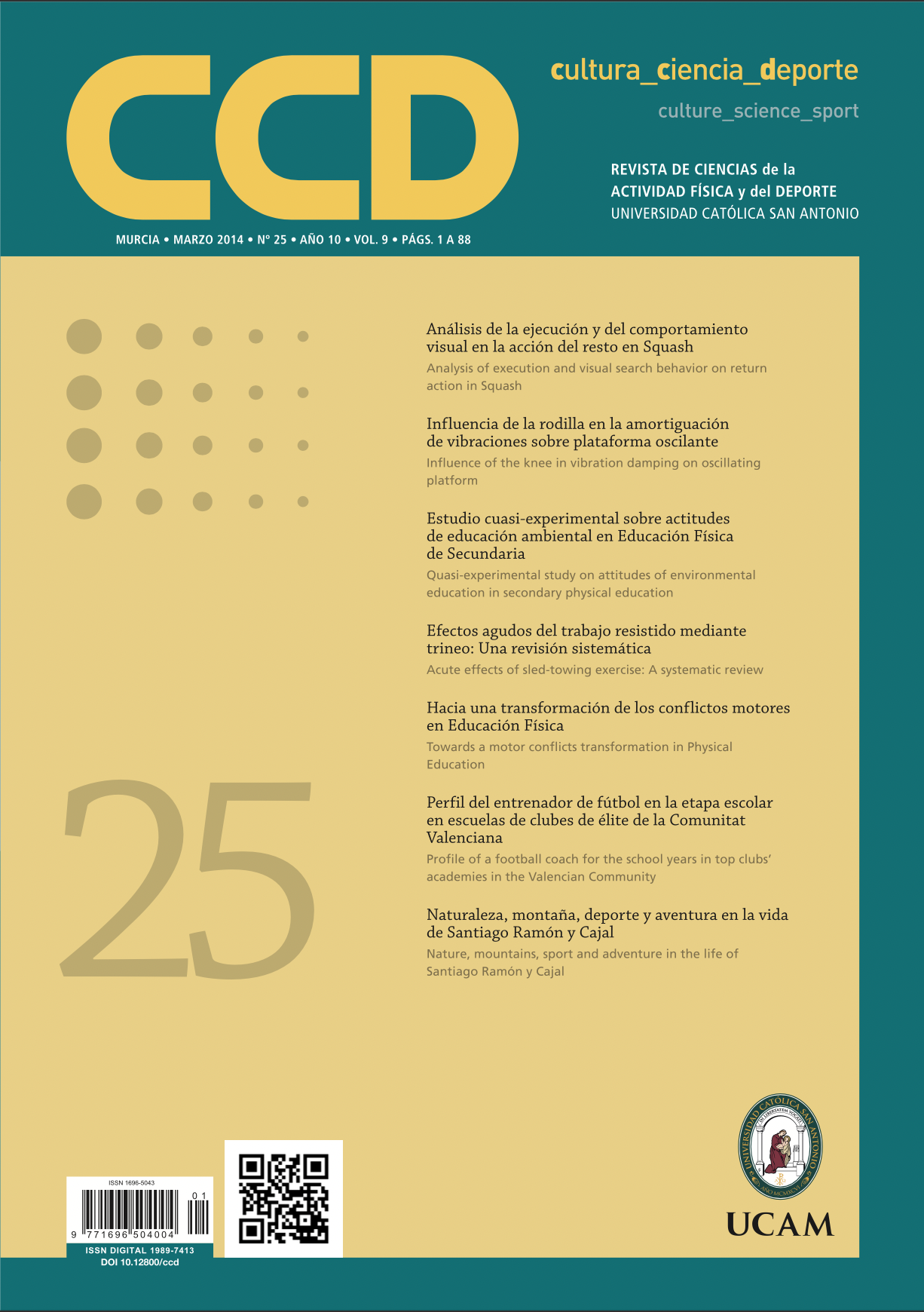Influencia de la rodilla en la amortiguación de vibraciones sobre plataforma oscilante. (Influence of the knee in vibration damping on oscillating platform).
DOI:
https://doi.org/10.12800/ccd.v9i25.385Resumen
http://dx.doi.org/10.12800/ccd.v9i25.385
La utilización de plataformas vibratorias se ha extendido en los ámbitos deportivo y clínico. Sin embargo, son escasos los trabajos sobre su correcta utilización y seguridad. En este estudio transversal se registró, en 22 sujetos sanos (23,7 ± 3,7 años, talla 1,75 ± 0,08 m, masa 71,63 ± 14,5 kg) con un nivel de actividad física bajo/medio, la aceleración en el eje vertical en la cabeza durante la posición de bipedestación sobre una plataforma vibratoria, en tres angulaciones distintas (180º, 150º y 120º), a tres frecuencias de vibración (5, 16 y 27 Hz) y a una amplitud constante (3 mm). El objetivo del estudio fue valorar la influencia de la posición de la rodilla sobre la transmisión de vibraciones desde la plataforma hasta la cabeza. Los resultados indican que la amortiguación de la vibración aumentó con cada incremento en el grado de flexión de la rodilla, siendo la influencia de la posición articular tanto más relevante cuanto mayor fue la frecuencia de vibración de la plataforma (p <0.001). Estos resultados sugieren que para la realización segura de ejercicios en bipedestación sobre plataforma vibratoria a intensidades altas debe evitarse la extensión completa de rodilla.
Palabras clave: Vibración, aceleración, transmisión, cabeza, amortiguación.
===
Abstract
The use of vibrating platforms both in sport and clinical contexts has become much more common, but studies on their safety and efficacy are still scarce. In this cross-sectional study, acceleration in the vertical axis for the head was recorded for 22 healthy subjects (23.7 ± 3.7 years, height = 1.75 ± 0.08 m, mass = 71.63 ± 14.5 kg) who had a low/moderate physical activity level, while standing on an oscillating platform at three different knee angles (180º, 150º and 120º), with three different vibrating frequencies (5, 16, and 27 Hz) and constant amplitude (3 mm). The aim of the study was to evaluate the influence of the position of the knee on the transmission of vibration from the platform to the head. The absorption of the vibration energy from the platform to the head was calculated for the different positions and vibrating frequencies under study. The absorption of the vibration energy increased with every knee flexion angle increment; the higher the vibrating frequency, the more influence the position exerted (p < 0.001). These results suggest that complete knee extension needs to be avoided for a safe physical exercise execution while standing on an oscillating platform that vibrates at a high intensity.
Key words: Vibration, acceleration, transmission, head, damping.
Descargas
Cómo citar
Número
Sección
Licencia
Los autores que publican en esta revista están de acuerdo con los siguientes términos:- Los autores conservan los derechos de autor y garantizan a la revista el derecho de ser la primera publicación del trabajo al igual que licenciado bajo una Creative Commons Attribution License que permite a otros compartir el trabajo con un reconocimiento de la autoría del trabajo y la publicación inicial en esta revista.













